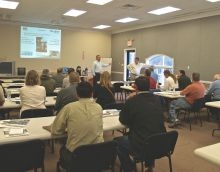Join Woodhaven for 2 AIA Certified Continuing Education classes presented by TruStile Doors and Smart Vent Foundation Flood Vents.
Registration begins at 7:30am. The first class starts at 8am.
A continental breakfast will be served.
Detailed class topics are below.
Space is limited. Please reserve your seat today.
We look forward to seeing you!
Transforming Residential Design Through Unique Applications of Interior Doors - 1 LU / HSW
This course demonstrates the role interior doors can play in transforming residential interior design.
• Highlight the role of interior door design during select architectural periods
• Review interior door application trends
• Explore new opportunities to design interior doors into projects
• Understand how doors interact with larger consumer trends
Floodplain Design, Construction, and Impacts on Flood Insurance - 1 LU / HSW
Floods are the #1 natural disaster in the United States. All 50 states have experienced floods or flash floods. Due to climate change and other factors, flood events are increasing in number and intensity. To protect the health, safety, and welfare of homes and their occupants during a flood event, homes must be built into compliance with local, state, and federal codes and regulations. This course describes floodplains and the potential hazards to buildings. Unless there are flood openings that allow floodwaters to flow into and out of enclosures below the Base Flood Elevation, hydrostatic pressure builds up on the foundation walls and can cause major damage. The course also defines the differences in engineered and non-engineered flood openings and their ability to ensure resilient structures. It explains the differences between wet floodproofing and dry floodproofing techniques, and when they are applicable. It also clarifies the regulations, codes, and standards as they relate to sustaining foundations in flood hazard areas. This course analyzes the role of building compliance in lowering flood insurance rates and what mitigation solutions are available to existing structures.
When you complete this course you will know how to:
- Describe floods, floodplains, and the potential hazards to buildings.
- Explain the differences between wet floodproofing and dry floodproofing techniques and acceptable applications.
- Describe the role of flood openings in flood events to ensure resilient structures
- Identify regulations, codes, and standards as they relate to sustaining foundations in flood hazard areas.
- Analyze the role of building compliance in securing lowering flood insurance rates and what mitigation solutions are available.


